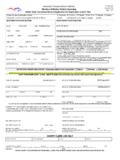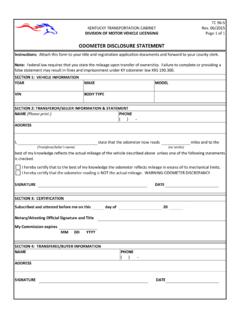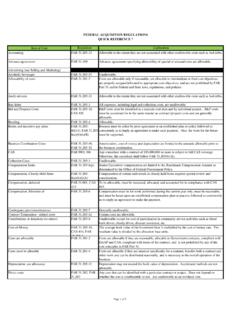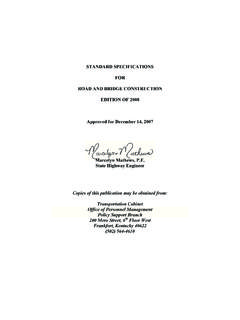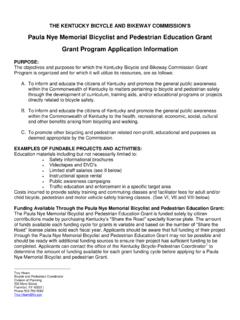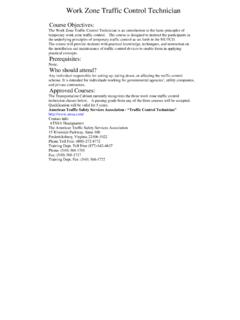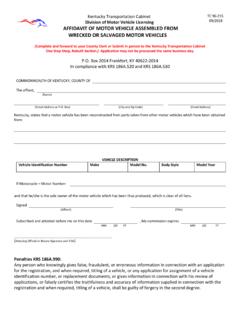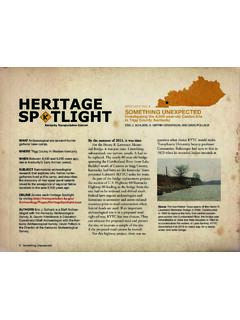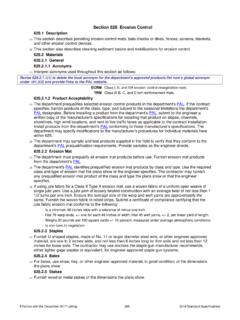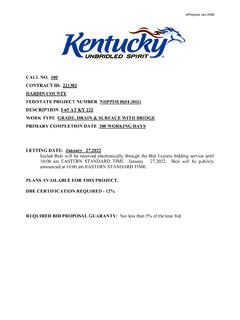Transcription of 4.5 Slope Protection - Kentucky Transportation Cabinet
1 Kentucky Construction Site BMP Planning and Technical Specifications Manual Slope ProtectionGeneral InformationRelatively flat areas those with slopes of 2 percent or less can be treated to a large extent through controlled clearing and grading, mulch, and temporary or permanent seed. Slopes greater than that, however, require more attention to sheet runoff volume and the management of areas where flows converge and are transported to downstream receiving waters. Sediment barriers, rolled erosion control products, and greater attention to downslope drainage are usually needed on slopes, especially those that are steep and section addresses erosion Protection and sediment control approaches specifically for slopes. In general slopes that are long (50 feet or more), steep (5 percent plus), and composed of highly erodible (silty) soils require more Protection that shorter, flatter slopes of less erodible soil. Slope Protection approaches discussed below include erosion control blankets and turf reinforcement mats, which can also be used for ditch Protection , surface roughening, Slope drains, gabion structures, and cellular Slope ConversionsApproximate Slope conversions (horizontal:vertical)PercentSlope RatioDegrees100%1:145 50%2:127 33%3:118 25%4:114 10%10:16 Slope Protection BasicsProtecting slopes from erosion requires several actions that must be taken together.
2 No single approach will be successful, especially if the Slope is steep or has highly erodible soils (see table). Use one or more of the following actions to reduce erosion on slopes:Divert upland runoff Install a berm or channel above the Slope to divert upland rain runoff around the bare soil area or a stable ditch to move upland flows through the site without picking up additional Slope runoff If slopes are broken up into benches or steps, runoff can be collected and diverted along berms or in channels to pipe or channel Slope seedbed or condition the soil Dozer tracks up and down slopes help hold soil in place. See the table below for information on how the condition of the soil surface ( , compacted, tracked) can increase or decrease and mulch This is the best and cheapest Protection by far. See temporary and permanent seeding Fact Sheets for details on seed types, application rates, and mulch, blanket, and mat fence or brush barrier These should be installed at the toe of the Slope , and every 75 to 125 feet apart on long wall Extremely steep slopes can be leveled out and shortened into two or more steps or benches by installing retaining walls of rock, brick, block, wood, logs, or other material.
3 If rock layers are present along the Slope , use these to establish firm benches in a stair-step or armoring Long slopes (greater than 100 feet) exceeding 3H:1V with highly erodible soils need to be protected with erosion control blankets or turf reinforcement mats. Rock mulch and lined downdrain channels might be needed on steep slopes to control gullying. 76 Technical Specifications for BMPsSoil Conditions vs. ErosionSoil Conditions vs. ErosionIf soil is:Erosion will be:Compacted and smooth30 percent moreTracks across slopes20 percent moreTracks up & down slopes10 percent lessRough and irregular 10 percent lessRough & loose to 12" deep20 percent lessSlope Angle and Soil Type vs. ErodibilitySlope angleErodibilitySoil type50%40%30%20%15%10%5%< 5%Very highVery LowSiltSilty sandClayey sandOrganic soilClaysSilty gravelSandGravelThe value of seed on a Slope : the left (seeded) section shows almost no erosion; right side rills are quickly becoming gullies.
4 Seed and mulch slopes as soon as final grade is established for best results. Bare areas must be seeded or mulched within 14 days if no work is planned during the next Construction Site BMP Planning and Technical Specifications Manual Slope Silt FenceDefinitionA silt fence is a temporary sediment barrier consisting of filter fabric entrenched into the soil and attached to supporting posts. Silt fences are downhill from bare soil areas and are installed with a trencher or by a slicing machine to prevent against common silt fence failures. Purpose Silt fences are common sediment control devices. Silt fencing should be installed where sediment-laden water can pond, thus allowing the sediment to fall out of suspension and separate from the runoff. Runoff will also bleed through the silt fence fabric, providing physical filtering for larger sediment particles. Reasons for the high failure rate of improperly designed (located) and installed silt fence include Improper placement on the site Allowing excessive drainage area to the silt fence structure Shallow trenches with little or no soil compaction Inadequate attachment to posts Failure to maintain the silt fence after installation Installing silt fence along property boundaries, producing concentrated runoffDesign Criteria Silt fencing must be installed only where water can pond.
5 Specify silt fencing downgradient from bare soil areas, installed on the contour if possible, with the ends turned up to prevent bypassing. Provide adequate setbacks from Slope toe for routine maintenance and access. Silt fencing can be used where Non-concentrated sheet flow will occur Protection of adjacent property or nearby surface waters is required The size of the drainage area is no more than 1/4 acre per 100 linear feet of silt fence The maximum flow path length above the barrier is 100 feet for slopes less than 2 percent, and 50 feet for slopes up to 10 percentSilt fencing is commonly used to pond, settle, and filter sediment from sheet runoff. Install at proper spacing on slopes; set back from Slope toe to allow for maintenance. Make sure fencing is trenched in properly and stakes are on the downhill side. Inspect frequently to detect and address bypasses, undercutting, and Technical Specifications for BMPs The maximum Slope gradient above the barrier is 2H:1V Silt fencing can be used in flat, short swales ( , Slope is less than 2 percent; length is less than 200 feet) that drain less than 2 acres, if silt fencing is spaced every 50 feet.
6 Reinforced silt fence must be required when the contributing Slope is longer than 100 feet and greater than 3 percent and the design life of the silt fence is greater than 6 Fence Spacing on Long SlopesLand SlopeMax. Slope Distance3% 5%100 10%75 20%50 50%25 fencing should not be used Around the perimeter of the construction site, unless J-hooks are used. Long continuous runs of silt fence will divert and concentrate sediment-laden runoff and almost certainly result in failure. A good general rule is to drain no more than 1/3 acre of disturbed area into each discrete J-hook; In ditches, channels, or streams. Silt fences cannot handle the volumes generated by concentrated channel flows. When installed across a concentrated flow path, undercutting or end cutting of the fence often occurs, or the fence is pushed over by the force of the SpecificationsSilt fences have a useful life of one season. Their principal mode of action is to slow and pond the water and allow soil particles to settle with some minor filtration through the fabric.
7 Silt fences are not designed to withstand high heads of water, and therefore should be located where only shallow pools ( , feet or less) can form. Their use is limited to situations in which sheet or overland flows are expected. Dig a trench on the contour at least 6 inches wide and 6 inches deep below the area to be treated, taking care to install J-hooks where flows will travel along the silt fence. Turn fence ends uphill to trap potential bypasses as needed. If posts are already attached to fabric, position the fencing so the posts are installed on the downhill side of the fabric. Drive posts to a depth of 1 foot below the bottom of the trench, against downslope trench wall for extra support. Posts for all silt fencing are spaced 6 feet apart. Push fabric into the trench, and spread fabric along trench bottom and sides; backfill the trench and compact the soil. A preferred installation technique in deep, easily-worked soils with minimal rock content involves static slicing of the fence into the ground with a chisel-plow implement such as the Tommy Silt Fence Machine or equivalent.
8 The filter fabric is wire-tied directly to the posts with three diagonal ties. The height of a silt fence must be 18 inches minimum and 30 inches maximum. Sediment storage height and ponding height must not exceed 18 inches. Silt fences placed at the toe of a Slope must be set at least 6 feet back from the toe to increase ponding volume and provide room for Construction Site BMP Planning and Technical Specifications Manual 79 Inspection and MaintenanceAll sediment barriers should be placed downgradient from bare areas to be treated. The ends of the barrier should be turned uphill or otherwise configured to prevent end-around bypasses. Inspect fence for proper installation and compaction by pulling up on the fence while kicking the toe of the fabric. If the fence comes out of the ground, do not accept the installation. If there are long, linear runs of silt fence without J-hooks, do not accept the installation. Silt fences and filter barriers must be inspected weekly and after each storm of greater than one-half inch.
9 Any required repairs must be made immediately. Sediment should be removed when it reaches 1/3 height of the fence or 18 inches maximum. The removed sediment must be spread and vegetated or otherwise stabilized so that it does not result in muddy runoff to nearby ditches or surface waters. Silt fences must be removed when they have served their useful purpose, but not before the upslope area has been permanently stabilized ( , vegetated) and any sediment stored behind the silt fence has been removed. Silt fences and other temporary controls must be removed before project sure silt fence fabric is trenched in and is upslope of stakes. Leave room between the fencing and the upgradient Slope for removing accumulated silt fencing on the contour, with the ends turned uphill to trap muddy runoff and prevent bypasses. Remove silt fences when grass is not use silt fencing in areas of concentrated flows. For best results, triple-seed ditches and line with erosion control Technical Specifications for BMPsSilt fence is functioning well, but needs maintenance.
10 Set fences back from the toe of the Slope , to allow room for sediment to accumulate and several short lengths of silt fence and J-hooks to intercept converging runoff in critical areas, such as property corners. This can help relieve stress and prevent failure at the fence installed backwards note that stakes are on the uphill, rather than downhill, side of the fabric. Ponding flows against this fence will push the fabric away from the stakes, causing failure and releasing sediment to the small stream on the multiple silt fences at proper spacing (see table) to protect long, unvegetated slopes. Fences provide only temporary Protection and can be removed when the area is seeded and installation of super ( , wire reinforced) silt fence. Note that wire is installed between the fabric and stakes, and provides a web of support as the ponded flow pushes against the fabric. Also, note the grass strip between the bare area and the fence, which helps to slow and filter flows before ponding along the fence Construction Site BMP Planning and Technical Specifications Manual 8182 Technical Specifications for BMPsKentucky Construction Site BMP Planning and Technical Specifications Manual 8384 Technical Specifications for BMPsKentucky Construction Site BMP Planning and Technical Specifications Manual 8586 Technical Specifications for Slope Brush, Rock, and Other Sediment BarriersDefinitionBrush, rock, and other commercial barriers can be used as a temporary sediment barrier instead of a silt fence.

